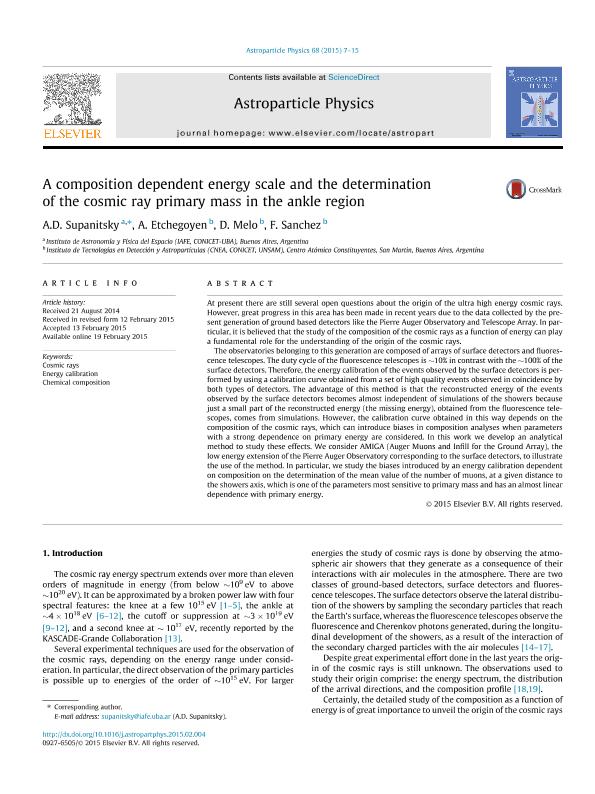Artículo
A composition dependent energy scale and the determination of the cosmic ray primary mass in the ankle region
Fecha de publicación:
02/2015
Editorial:
Elsevier
Revista:
Astroparticle Physics
ISSN:
0927-6505
Idioma:
Inglés
Tipo de recurso:
Artículo publicado
Clasificación temática:
Resumen
At present there are still several open questions about the origin of the ultra high energy cosmic rays. However, great progress in this area has been made in recent years due to the data collected by the present generation of ground based detectors like the Pierre Auger Observatory and Telescope Array. In particular, it is believed that the study of the composition of the cosmic rays as a function of energy can play a fundamental role for the understanding of the origin of the cosmic rays.
The observatories belonging to this generation are composed of arrays of surface detectors and fluorescence telescopes. The duty cycle of the fluorescence telescopes is ∼10% in contrast with the ∼100% of the surface detectors. Therefore, the energy calibration of the events observed by the surface detectors is performed by using a calibration curve obtained from a set of high quality events observed in coincidence by both types of detectors. The advantage of this method is that the reconstructed energy of the events observed by the surface detectors becomes almost independent of simulations of the showers because just a small part of the reconstructed energy (the missing energy), obtained from the fluorescence telescopes, comes from simulations. However, the calibration curve obtained in this way depends on the composition of the cosmic rays, which can introduce biases in composition analyses when parameters with a strong dependence on primary energy are considered. In this work we develop an analytical method to study these effects. We consider AMIGA (Auger Muons and Infill for the Ground Array), the low energy extension of the Pierre Auger Observatory corresponding to the surface detectors, to illustrate the use of the method. In particular, we study the biases introduced by an energy calibration dependent on composition on the determination of the mean value of the number of muons, at a given distance to the showers axis, which is one of the parameters most sensitive to primary mass and has an almost linear dependence with primary energy.
Palabras clave:
Cosmic Rays
,
Energy Calibration
,
Chemical Composition
Archivos asociados
Licencia
Identificadores
Colecciones
Articulos(IAFE)
Articulos de INST.DE ASTRONOMIA Y FISICA DEL ESPACIO(I)
Articulos de INST.DE ASTRONOMIA Y FISICA DEL ESPACIO(I)
Articulos(ITEDA)
Articulos de INSTITUTO DE TEC. EN DETECCION Y ASTROPARTICULAS
Articulos de INSTITUTO DE TEC. EN DETECCION Y ASTROPARTICULAS
Citación
Supanitsky, Alberto Daniel; Sanchez, Federico Andrés; Melo, Diego Gabriel; Etchegoyen, Alberto; A composition dependent energy scale and the determination of the cosmic ray primary mass in the ankle region; Elsevier; Astroparticle Physics; 68; 2-2015; 7-15
Compartir
Altmétricas




